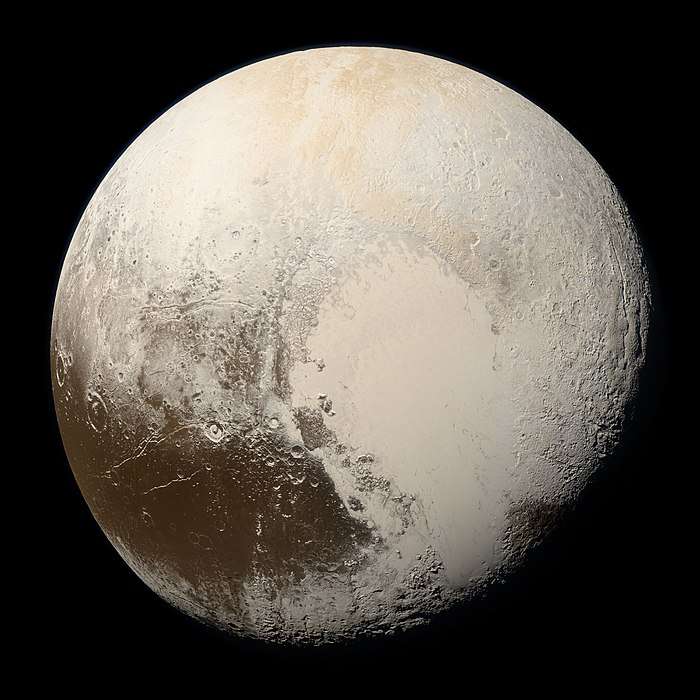(523727) 2014 NW65
(523727) 2014 NW65, provisional designation 2014 NW65, is a large centaur from the outer Solar System, approximately 220 kilometers (140 miles) in diameter. It was discovered on 14 July 2010 by astronomers with the Pan-STARRS-1 survey at Haleakala Observatory, Hawaii, in the United States.[1] According to American astronomer Michael Brown, it is "possibly" a dwarf planet.[5] The minor planet was numbered in 2018 and has not been named.
| Discovery [1] | |
|---|---|
| Discovered by | Pan-STARRS 1 |
| Discovery site | Haleakala Obs. |
| Discovery date | 14 July 2010 |
| Designations | |
| (523727) 2014NW65 | |
| centaur [2][3][4] · distant [1] | |
| Orbital characteristics [2] | |
| Epoch 27 April 2019 (JD 2458600.5) | |
| Uncertainty parameter 2 | |
| Observation arc | 8.07 yr (2,949 d) |
| Aphelion | 35.111 AU |
| Perihelion | 11.178 AU |
| 23.145 AU | |
| Eccentricity | 0.5170 |
| 111.35 yr (40,670 d) | |
| 298.27° | |
| 0° 0m 32.04s / day | |
| Inclination | 20.461° |
| 215.80° | |
| 233.29° | |
| Physical characteristics | |
Mean diameter | 212 km[3] 225 km[5] |
| 0.08 (est.)[5] 0.09 (est.)[3] | |
| 6.6[1][2] 6.7[5] | |
Orbit and classification
2014 NW65 is a member of the centaurs, an inward-moving population of bodies transiting from the Kuiper belt to the group of Jupiter-family comets. Their eccentric orbits are often in between those of Jupiter and Neptune, that is, they have a semi-major axis of typically 5.5 to 30.1 AU. Centaurs are cometary-like bodies. They have a short dynamical lifetime due to the perturbing forces exerted on them by the Solar System's outer planets.
It orbits the Sun at a distance of 11.2–35.1 AU once every 111 years and 4 months (40,670 days; semi-major axis of 23.15 AU). Its orbit has an eccentricity of 0.52 and an inclination of 20° with respect to the ecliptic.[2] The body's observation arc begins with its official discovery observation in July 2010.[1]
Numbering and naming
This minor planet was numbered by the Minor Planet Center on 25 September 2018 (M.P.C. 111779).[6] As of 2018, it has not been named.[1]
Physical characteristics
Diameter and albedo
2014 NW65 has an absolute magnitude of 6.6.[1] According to the Johnston's archive and astronomer Michael Brown, it measures 212 and 225 kilometers in diameter, based on an assumed albedo for the body's surface of 0.09 and 0.08, respectively.[3][5] It is one of the largest centaurs, comparable in size with 2060 Chiron, 10199 Chariklo, and 54598 Bienor.
According to Brown, 2014 NW65 is "possibly" a dwarf planet, which is the weakest of the 5 categories established by the astronomer.[5] As of 2018, no physical characteristics have been determined from photometric observations. The body's color, rotation period, pole and shape remain unknown.[2][7]
References
- "523727 (2014 NW65)". Minor Planet Center. Retrieved 18 October 2018.
- "JPL Small-Body Database Browser: 523727 (2014 NW65)" (2018-08-10 last obs.). Jet Propulsion Laboratory. Retrieved 18 October 2018.
- Johnston, Wm. Robert (7 October 2018). "List of Known Trans-Neptunian Objects". Johnston's Archive. Retrieved 18 October 2018.
- "List Of Centaurs and Scattered-Disk Objects". Minor Planet Center. Retrieved 18 October 2018.
- Brown, Michael E. "How many dwarf planets are there in the outer solar system?". California Institute of Technology. Retrieved 18 October 2018.
- "MPC/MPO/MPS Archive". Minor Planet Center. Retrieved 18 October 2018.
- "LCDB Data for (523727)". Asteroid Lightcurve Database (LCDB). Retrieved 18 October 2018.
External links
- List Of Centaurs and Scattered-Disk Objects, Minor Planet Center
- (523727) 2014 NW65 at AstDyS-2, Asteroids—Dynamic Site
- (523727) 2014 NW65 at the JPL Small-Body Database
_(cropped).jpg)
